Partly located on a cliff along the Gulf of Guinea in West Africa is the city of Accra, Ghana. One of the largest and most influential cities in West Africa, Accra stands on the shoulders of the legendary cities and kingdoms in the region that thrived before it, from the mighty Ashanti and Mali Empires to the city of Timbuktu. The large, youth-skewing city has a complicated history and a beautiful culture, both of which greatly influence the things you must do in Accra, Ghana.

Accra was first settled by the Ga people, who lived in many villages and settlements in the area when the Portuguese arrived in 1482. One of these was Ayawaso, the settlement from which the Ga tribe ruled. Later, in the 17th century, three European trading posts were established along the coast.
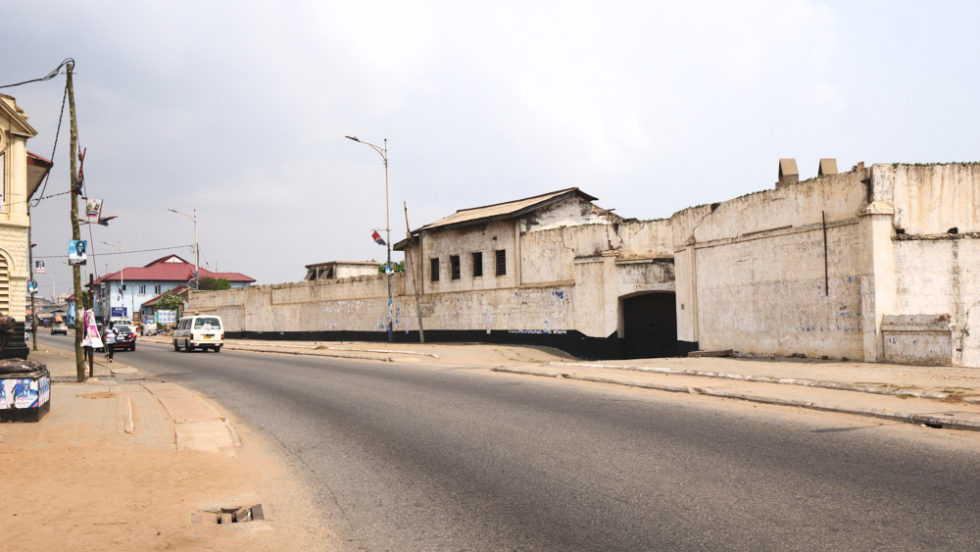
Fort Crèvecœur, built by the Dutch in 1649, was the first of the three to spring up. It was followed by the Danish Fort Christiansbourg in 1661. Now known as Ussher Fort, and Fort James, built by the English, in 1673. During that same period, Ayawaso fell during a tribal war.

After the destruction of Ayawaso, the Ga people moved closer to the coast in the hopes of trading with the Europeans. They established three villages along the coast: Osu, Dutch Accra (later known as Usshertown), and Jamestown. These villages later grew and merged to form Accra, which grew into a prominent trading center.
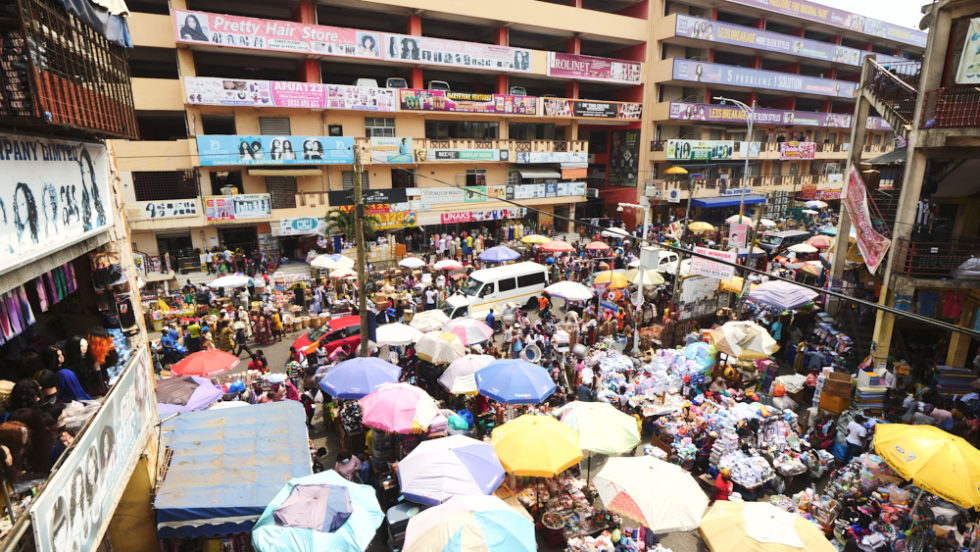
The city continued to prosper after the Danes and Dutch left in the mid- to late 19th century. Accra became the capital of the British Gold Coast colony in 1877. After a council to improve the growing town formed in 1898, the city of Accra was laid out, systematically, by the 1930s.
Accra is a beautiful, fascinating city that’s full of lively culture, unique history, and downright heavenly food. It’s exactly the type of place I love to dive deep into, but it doesn’t come without its challenges. As a travel content creator who films my adventures and shares them with the world, it was harder to do so in Accra.
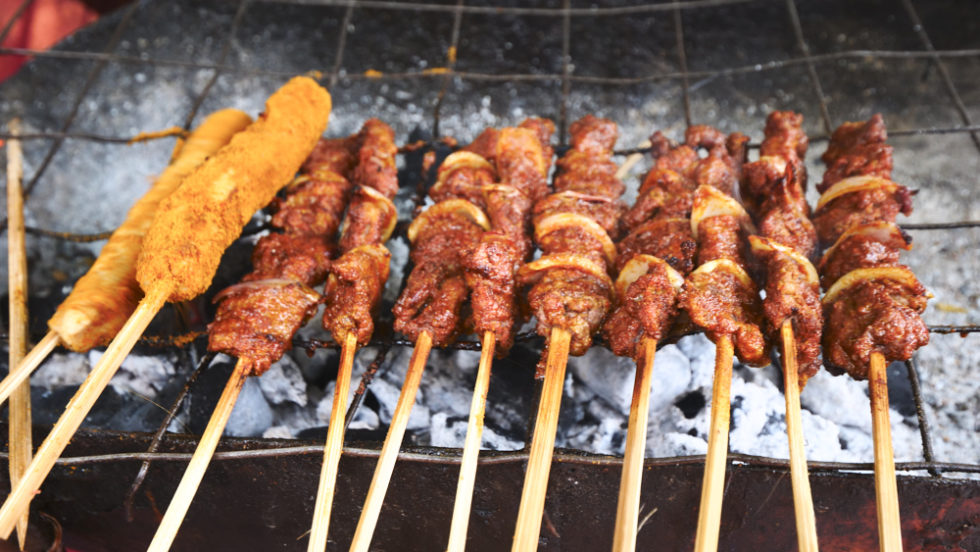
I learned from my guides that many of the locals were apprehensive about my filming. They were worried that I, a white foreigner, might present them and their country in a negative light. Some locals even refused to be on-camera, and some establishments would not allow me to film on their premises.

While I was successful in reassuring some locals that I just wanted to document and observe them and their culture, other locals weren’t as receptive. Just remember this if you travel to Ghana with a camera, and always respect their requests. The locals have very good reasons for being leery and it may take some extra effort to earn their trust.
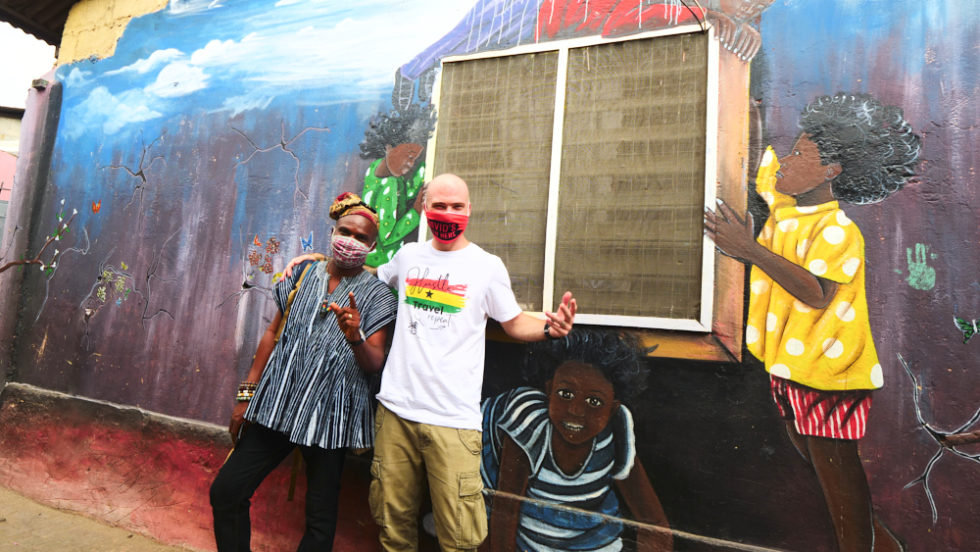
That said, my time in Accra was amazing. I explored the city for three days with my guides Isaac and Apollo and driver Ben from Jolinaiko Eco Tours, and a local guide named Nii Laaye. My time there really was a peek into another world. Day after day, I found myself more enamored by the food, culture, and people. It may be a culture shock for some, but exploring Accra, and Ghana as a whole, is one of my favorite recent travel experiences. These are the top things you must do in Accra, Ghana!
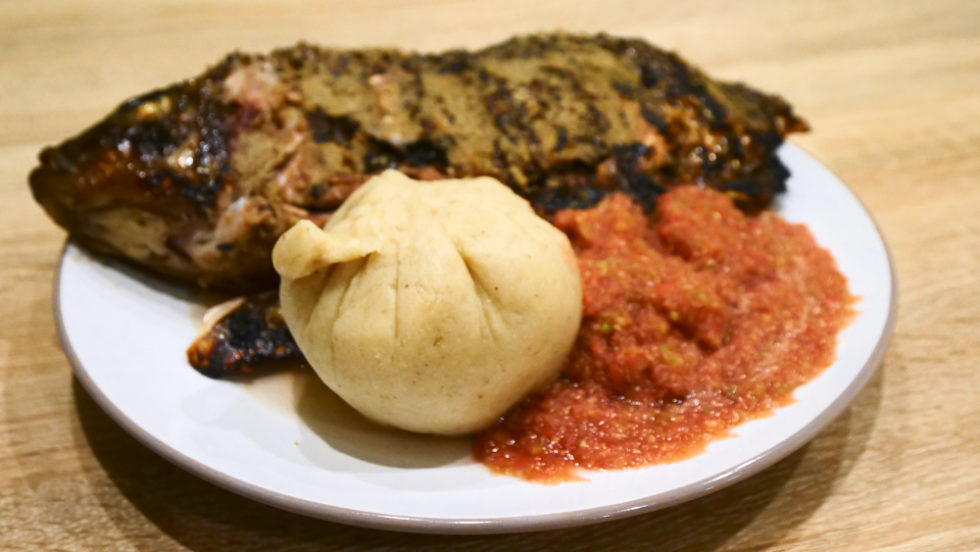
Ghanaian cuisine is very rich and diverse, but there are also several dishes you can find just about anywhere in the country. One of them is banku, a thick and sticky ball of fermented dough made from steamed, mashed corn and cassava.
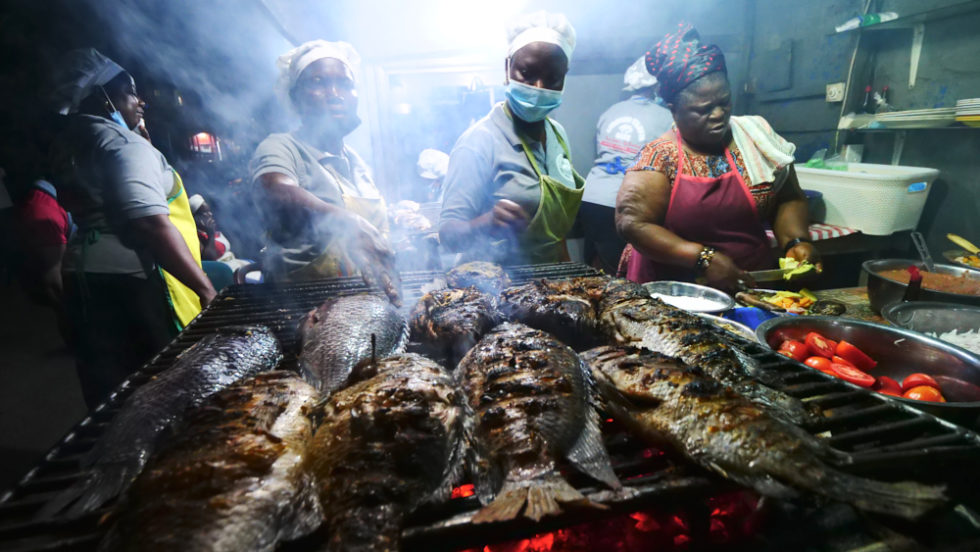
Just hours after arriving in Accra, my guide Isaac took me to a street food vendor just two minutes from my accommodations in the trendy Osu neighborhood. There, I had my very first taste of banku. It came with crispy, grilled tilapia, fresh vegetables including tomatoes and onion, and a peppery tomato-based sauce called shito. You break off bits of fish (careful of the bones), grab a bit of banku, a dollop of shito and veggies, and eat with your hands!

The starchy and sour banku’s purpose is to be filling. It pairs very nicely with the fish and shito, and was a great introduction into Ghanaian cuisine. The meal only cost 102 Cedi, or about $11 USD for my guide and I to eat, and was more than worth it. It was so good that I enjoyed the same meal, from the same vendor, again on my last night in town before setting off to Cape Coast!

Two of the three villages that sprang up around European forts in the 17th century and eventually merged to become Accra, are Jamestown and Usshertown. Formerly known as Dutch Accra, Usshertown, along with Jamestown, are still very much fishing communities home to the Ga people. Visiting them is a raw and real look into community life in the city, and one of my top things to do in Accra, Ghana.
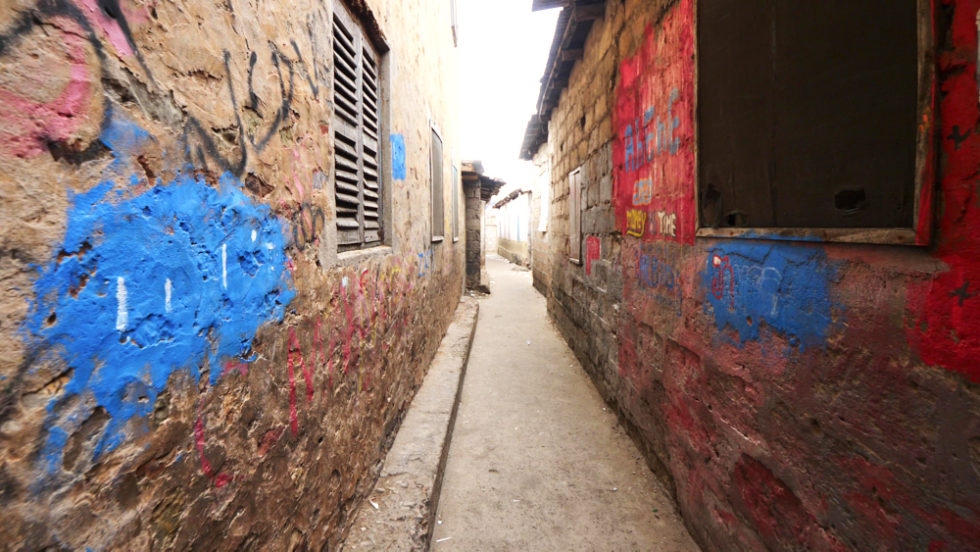
Made up of tight lanes and alleys that wind their way between proud, culture-rich homes and businesses, Jamestown and Usshertown is a feast for the senses. It’s a flurry of activity, from locals making books and notebooks right on the street. You’ll also find street vendors boiling fruit candy, preparing chicken, and butchering fish.
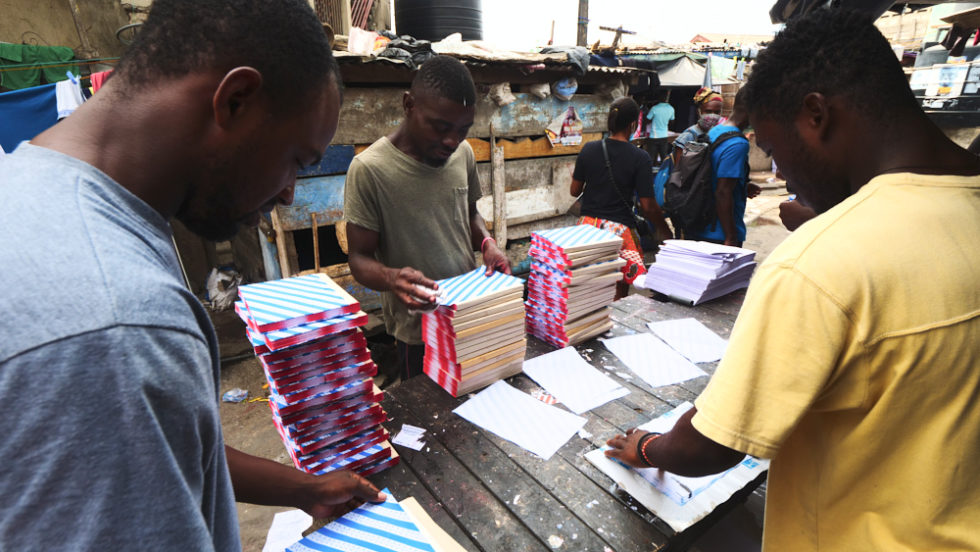
The shanty-like homes are bright and colorful, and often decorated with images of loved ones who have died. Cloths hung outside the homes give passersby indications of the person’s life. A white cloth for an 81-year-old woman means she lived a long life, while a red cloth hanging outside another home denoted a 40-year-old man who died painfully.
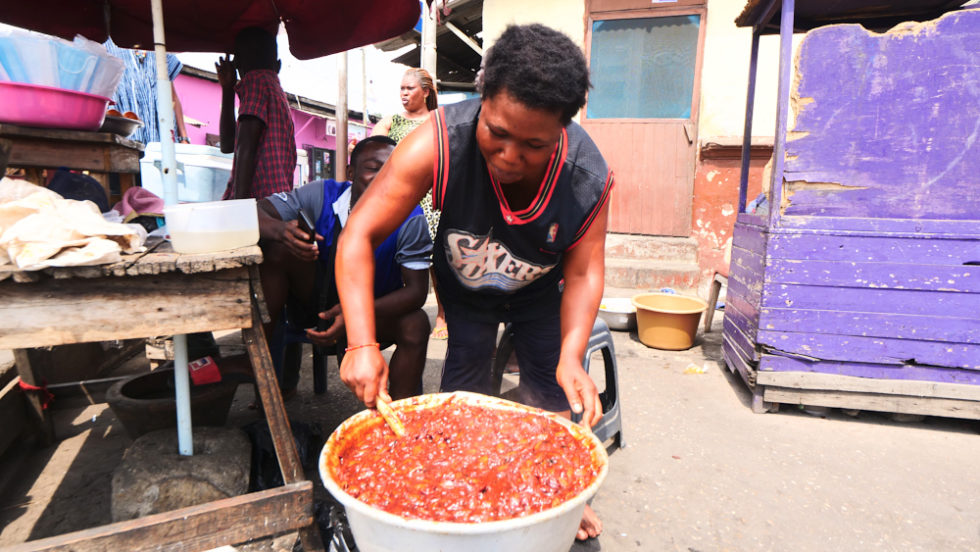
One of the most fascinating things I learned during my visit was the story of the Estabon people. They were slaves, living back in the 1840s, who became fed up with their captors. Surprisingly, they were allowed to return to their homeland. After they returned home, they were asked by their fellows, “Esta bon?”, which translates to “Are you good” or “Are you okay?”
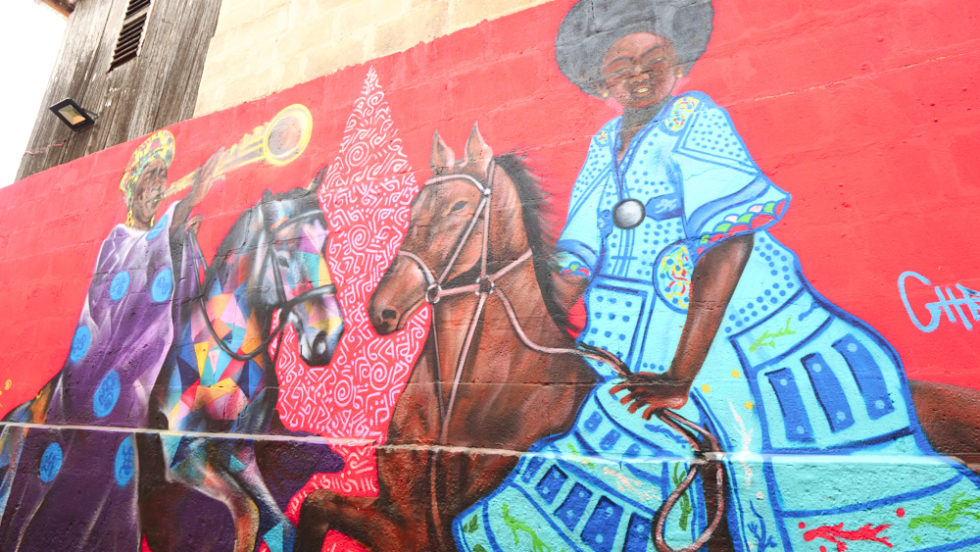
As you make your way through the backstreets of Usshertown, you’ll come across vibrant murals on the sides of homes and businesses. Nearly all of them depict women on horses, but you’ll also find murals containing Ghanaian symbols, messages of unity, birds, and much more!
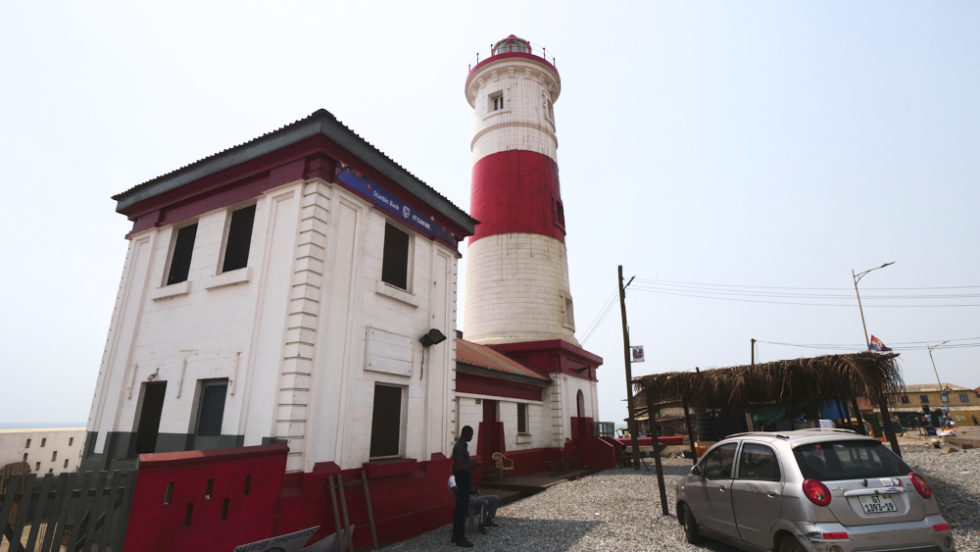
Two of the most prominent landmarks in Accra are the Jamestown Lighthouse, Fort James, and Ussher Fort. All three can be found in the Jamestown/Usshertown area. The lighthouse, a 92-foot-tall white-and-red beacon, dates back to the 1870s, though the current lighthouse was rebuilt in 1930.

Ussher Fort, the former Dutch Fort Crèvecœur, stands on the Gulf of Guinea coast and looks out over a sandy and rocky beach. On the beach is a pier, which serves as the local fishermen’s port. If you visit in the morning like I did, you may get to see fishermen out on the beach and a number of wooden boats out in the water.

During my exploration of Usshertown and Jamestown, my guides and I came across a number of vendors, including a group of women preparing a local favorite. They were making kenkey, which like banku is a dough, but made solely from ground corn.

The women pat the dough into balls, which they wrap with corn leaves and steam. Then it’s cooked a second time and wrapped in a corn husk. These women make hundreds of servings of kenkey per day!
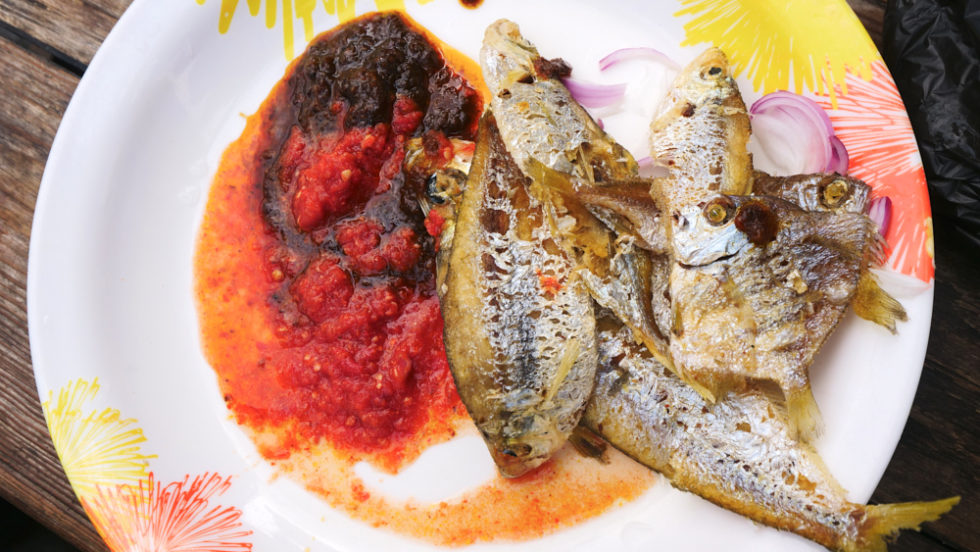
They serve the kenkey with small, bony fried fish and shito. The crunchy, salty fish works nicely with the acidic shito and the fermented kenkey.
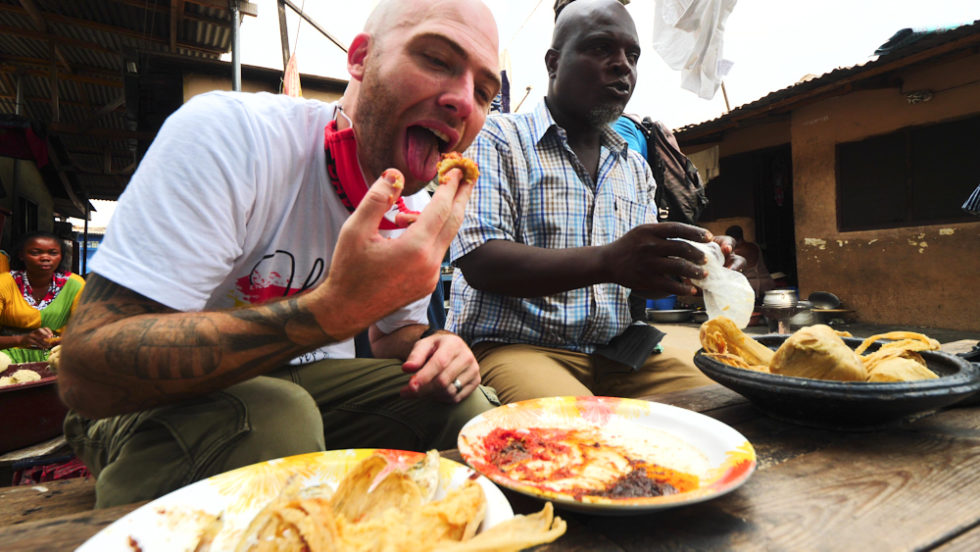
Best of all, the fish are so small that you can eat them whole. Just be sure to chew them thoroughly so you break down the tiny bones in your mouth! Authentic, local experiences like these are why I travel, so it’s easily one of the top things to do in Accra, Ghana!
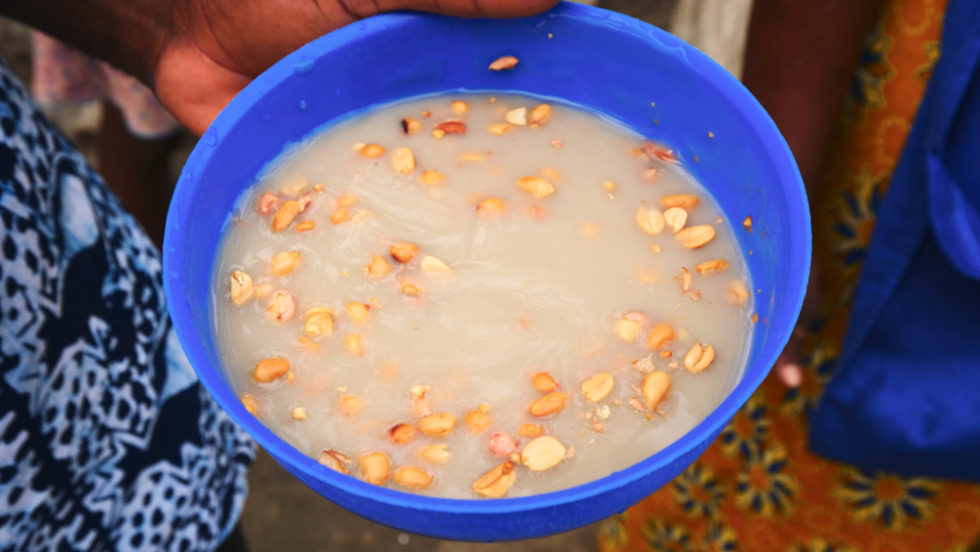
If you’re on the lookout for another common breakfast in Accra, you can find another option along Oxford Street. There, I found a woman selling a type of porridge made from a grain called millet. You can ask her to add sugar and/or peanuts to the porridge and sells it alongside a snack called bofrot, which is similar to a donut hole.
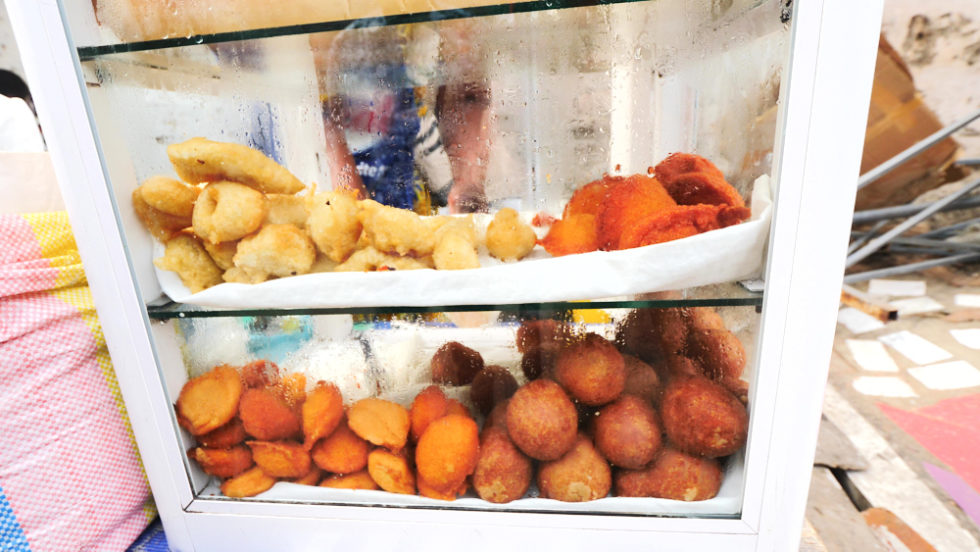
As is the case with most starchy Ghanaian dishes, the whole point of the porridge is to fill you up. The addition of sugar makes the porridge less bland and a bit more flavorful, and the peanuts add a nuttiness and a nice crunch.

I suggest taking some of the bofrot and dipping them into the porridge for a nice, sweet combination. A bowl should keep you full for hours, and at only 2.5 Cedi/$0.43 USD for everything, it’s a humble and inexpensive way start your day!

If the Jamestown and Usshertown neighborhoods are great places to immerse yourself in community life, the best place in town to get a good look at daily life is Makola Market. It’s the main market in town and is mainly located along a central street but has expanded to other neighboring streets as well.

Built in 1924 and considered a symbol of urban life in Accra, this expansive market in the city center sells everything from produce to clothing to jewelry to fresh meat.

Makola Market is also very much dominated by female vendors who sell more unique offerings like live snails and crabs and traditional medicines. The market is rustic and crowded, with indoor and outdoor areas.

The aromas of various foods and spices will waft over you as you navigate the tight paths. The best way to get a true sense of how large the market is, is to view it from the balcony of a nearby building. Thousands of people shop there every day!

The vendors there were quite friendly—many of them kept jokingly referred to me as “the blonde guy” or “the white guy.” They let me check out their products, which ranged from a dried grass used as an exfoliant to bags of sea salt to beautiful unisex fabrics with intricate designs on them.

With so much activity, it’s easy to get overwhelmed there. There’s so much to do and look at, and you can buy just about anything. If you’re looking for souvenirs, it’s easily one of the top things to do in Accra, Ghana!
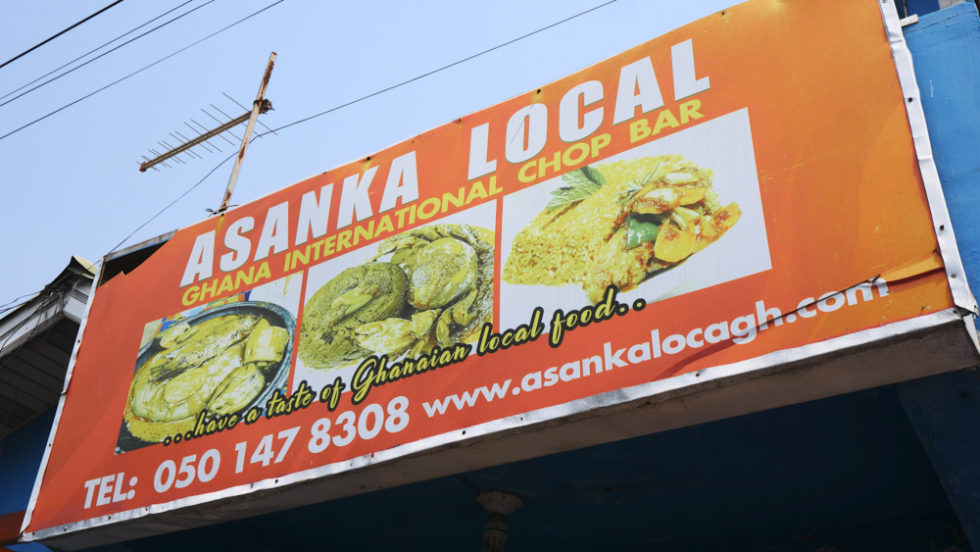
When it comes to places to eat in Ghana, you can’t go far without coming across a chop bar. In the Ghanaian language, “chop” means “to eat,” so chop bars are essentially a “place to eat.” One of the best in town is Asanka Local Ghana International Chop Bar in the Osu neighborhood.
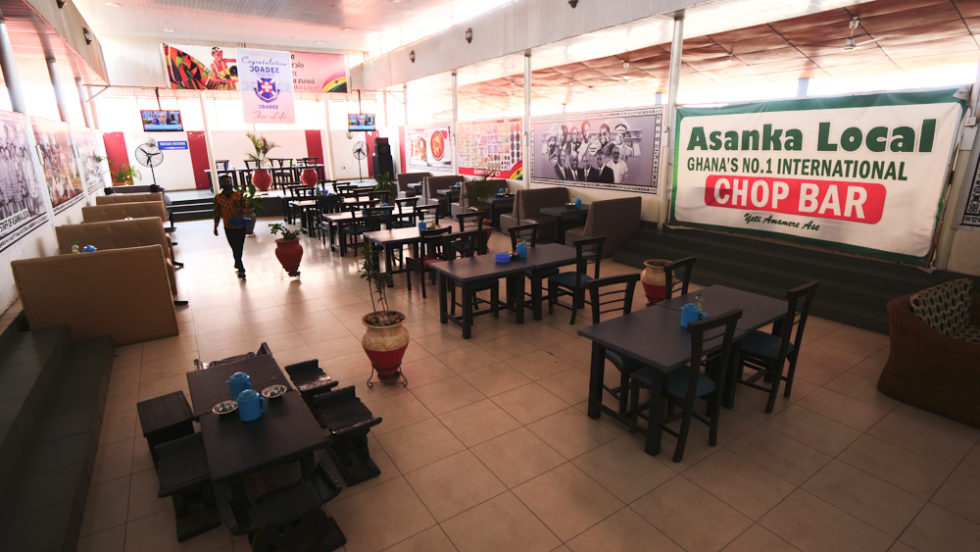
You can try a bitter, medicinal alcoholic drink that’s made from plants and has an earthy, herbal flavor. But the real treat are the local dishes called red red, and gari, which you can eat alongside plantains and a delicious roasted chicken.

Red red is a type of rustic stew made from black-eyed peas, peppers, a mix of spices, and the reddish palm oil that give the dish its name. The gari is a textured cassava flour that you sprinkle over everything and adds a nice crunch.

The red red is incredibly creamy and flavorful and goes well with the tender chicken, sweet plantains, and gari. The plantains reminded me of maduro, a dish I’ve eaten in lots of Latin American countries. I couldn’t get enough of the flavor and texture combinations!

Another dish you can try, which our driver Ben enjoyed, was fufu, which is another starchy, doughy food made from pounded cassava root. It’s served in a delicious stew along with meat and spices!
Asanka Local Ghana International Chop Bar
Adzoatse St
Osu
Accra, Ghana
+233 50 147 8308
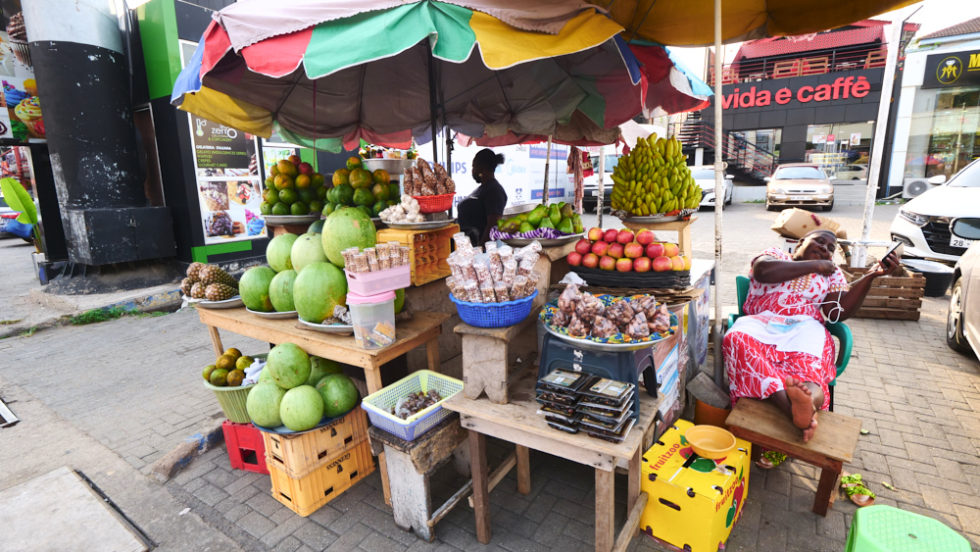
As I mentioned earlier, the Osu neighborhood is the trendiest area in Accra. You’ll find lots of shops, hotels, restaurants, and nightlife there, but it’s a lot more than just an entertainment district.

In the neighborhood, you’ll find a number of gorgeous, vibrant murals under an overpass just a couple of minutes from Oxford Street. The murals depict colorful skirts, Ghanaian women, and space.
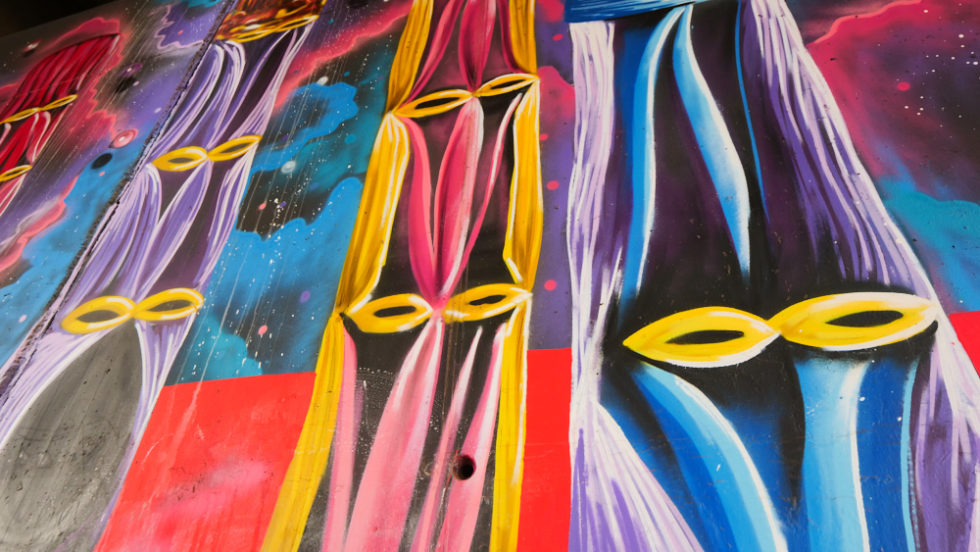
Others depict spirits that protect their community after nightfall. The murals alone make exploring Osu one of the top things to do in Accra, Ghana, but there’s more to find on Oxford Street itself.
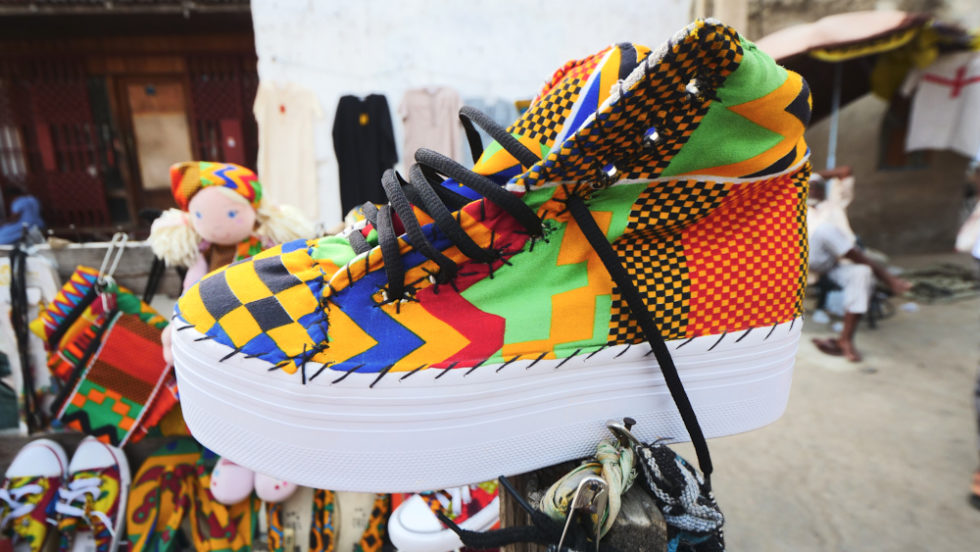
Elsewhere, on Oxford Street, you’ll find a number of vendors who sell everything from uniquely decorated Converse All-Stars to textiles to leather goods. There’s a man there named Elvis who sells gorgeous paintings and others who will sew your name into a bracelet!

If you’re interested in souvenirs, you can find street vendors selling stunning masks from Ghana, Benin, and Togo. They have a wide variety to choose from, including an elaborate black elephant mask that only cost about $200 USD. Nearby are other vendors selling drums, unity bowls, carvings, and animal figurines!
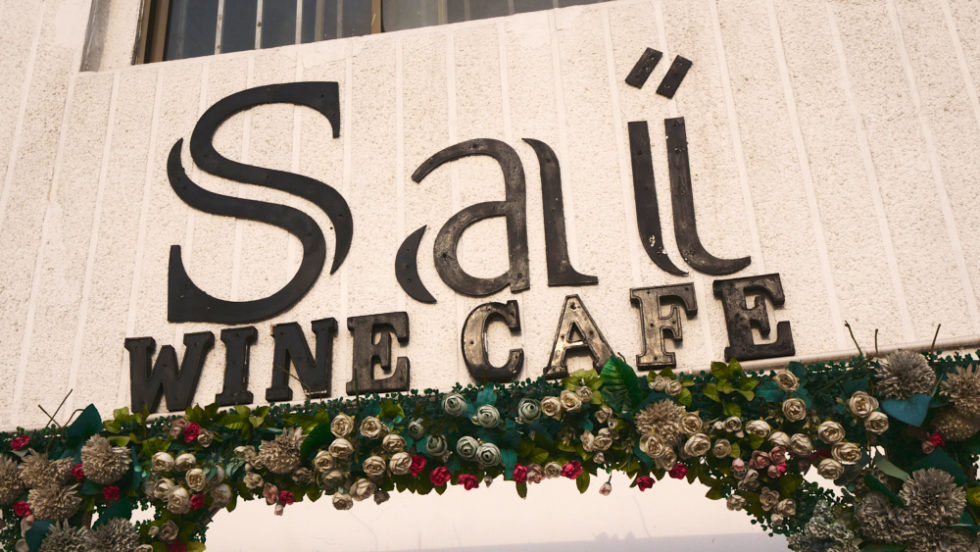
You might not think Ghana produces wine, but you’d be wrong. And in true Ghanaian fashion, their wines are quite unique. To try them, head over to Sai Wine & Champagne Café.
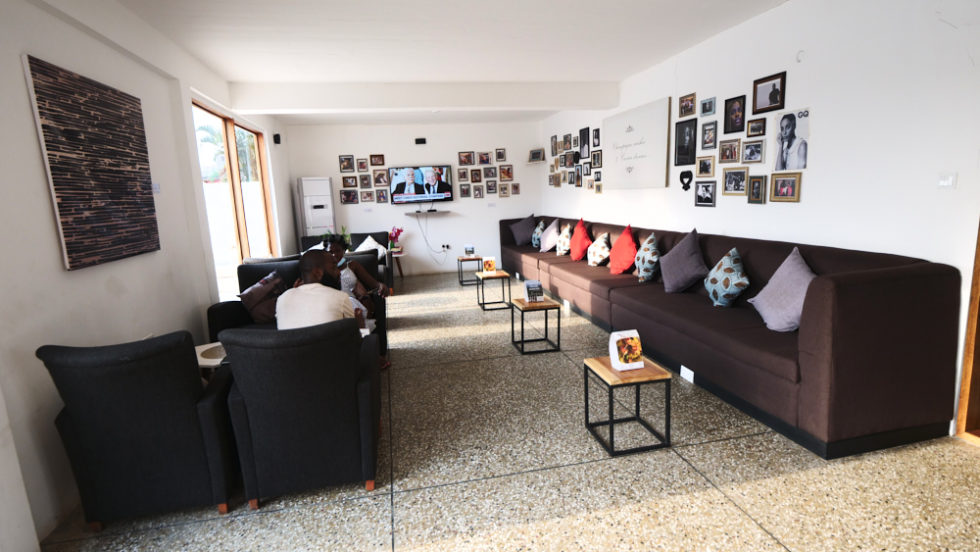
There, you can try a couple of white wines from the Volta Region. These wines are one-of-a-kind, as they’re not made from grapes! One of them is made from cashews while the other is made from cocoa! They’re the first wines produced in Ghana!

I was a big fan of the dryness and earthiness of the cashew wine, which also contained hints of curry leaves. The flavor profile was so different from wines made from grapes. Meanwhile, the cocoa wine had a cider-like aroma and an earthy, farmhouse saison-like flavor. It was pretty far from what I was expecting but was extremely tasty!
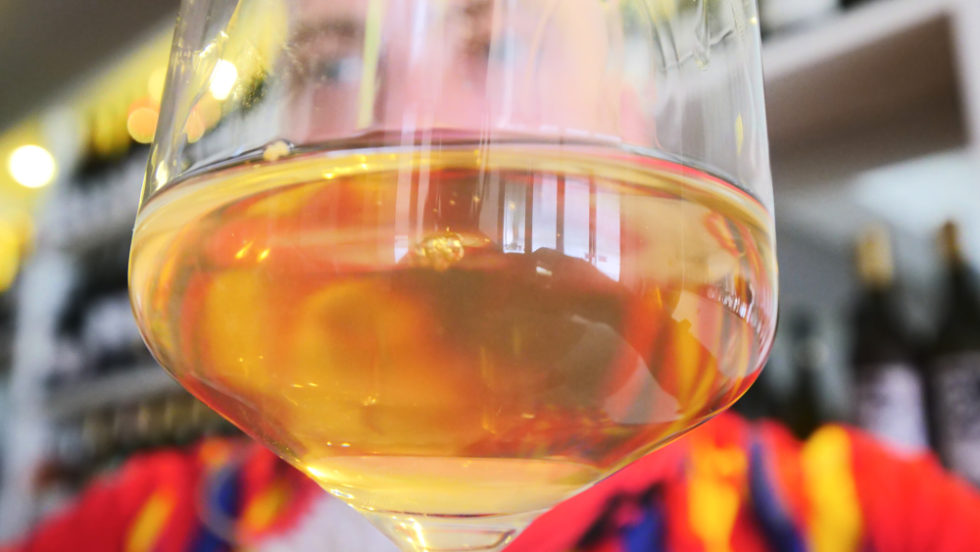
If you’re a fan of good, unique wines, you cannot miss Sai Wine & Champagne Café. It’s only list of the top things to see and do in Accra, Ghana for a reason. Just drink responsibly and have fun!
Sai Wine & Champagne Café
6, 8 Koi St
Accra, Ghana
+233 20 690 5257
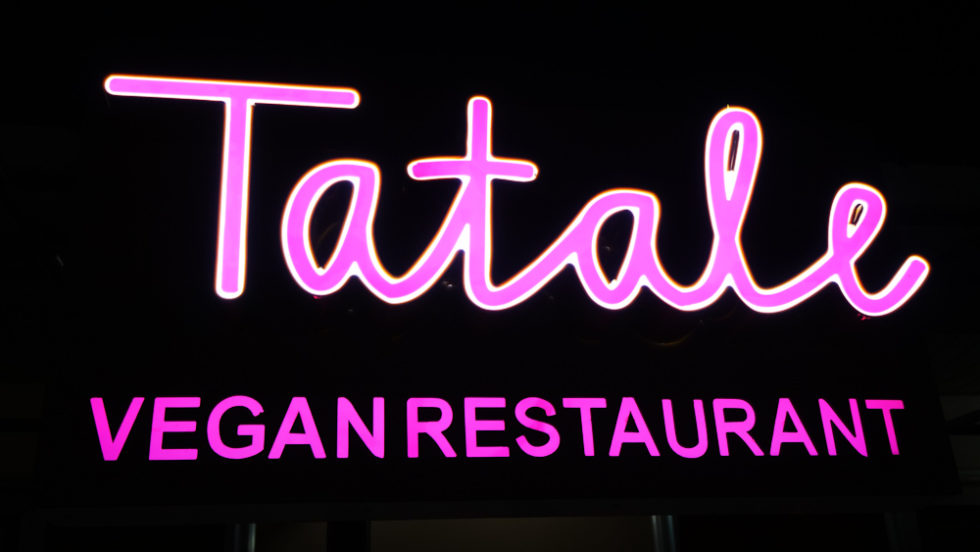
Although most of the meals I enjoyed in Ghana contained some sort of meat, there is also a growing vegan movement in the capital. At Tatale Vegan Restaurant, a local restaurant that specializes in plant-based Ghanaian dishes, you can try a host of modern vegan dishes!

I visited the restaurant with my friend Lotte from Ghana Food Movement, an organization that promotes the local food culture. First, we tried Tatale’s plantain cakes and cassava bake. The cassava bake contains yams and hot sauce, while the plantain cakes were like a dense, fried plantain block but also had some savory flavor to it.
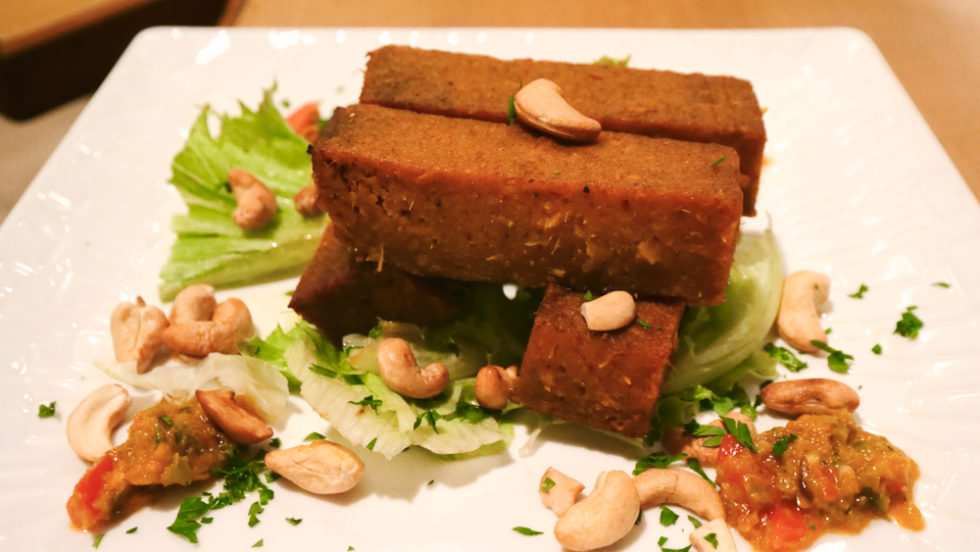
Their Tatale kebab, which contains pumpkin, tofu, cauliflower, carrots, eggplant, and squash was light and simple but bursting with flavor. But my favorite dish was the egusi, a dish that’s particularly popular in Nigeria. It’s creamy dish containing spinach, red palm oil, and melon seeds.
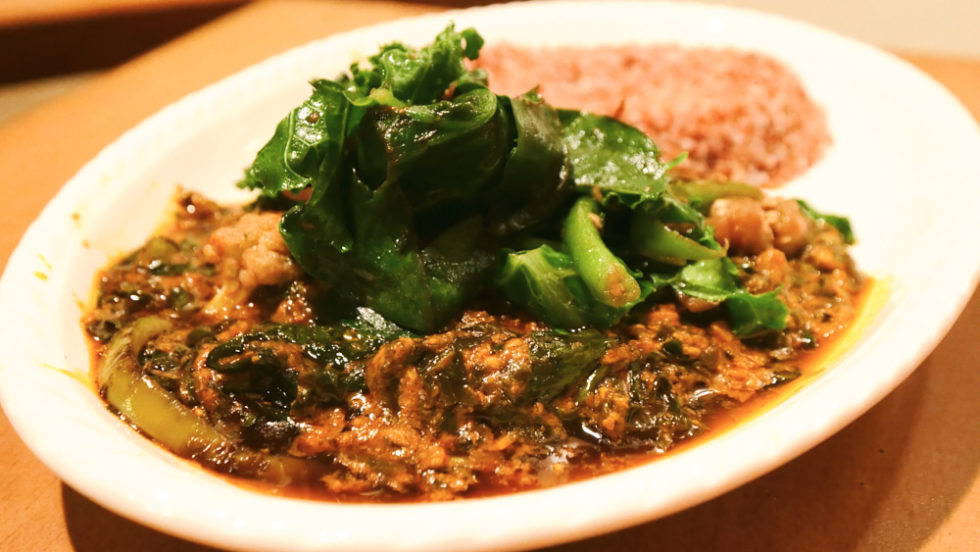
The egusi was one of my favorite—if not my favorite—dish of my entire Ghana trip! I also recommend the abolo, a corn mash that comes with black-eyed beans, zucchini, and okra. You can’t really go wrong at Tatale Restaurant, so order a few things and see which one you like the most!
Tatale Vegan Restaurant
18th Ln
Accra, Ghana
+233 30 295 6020
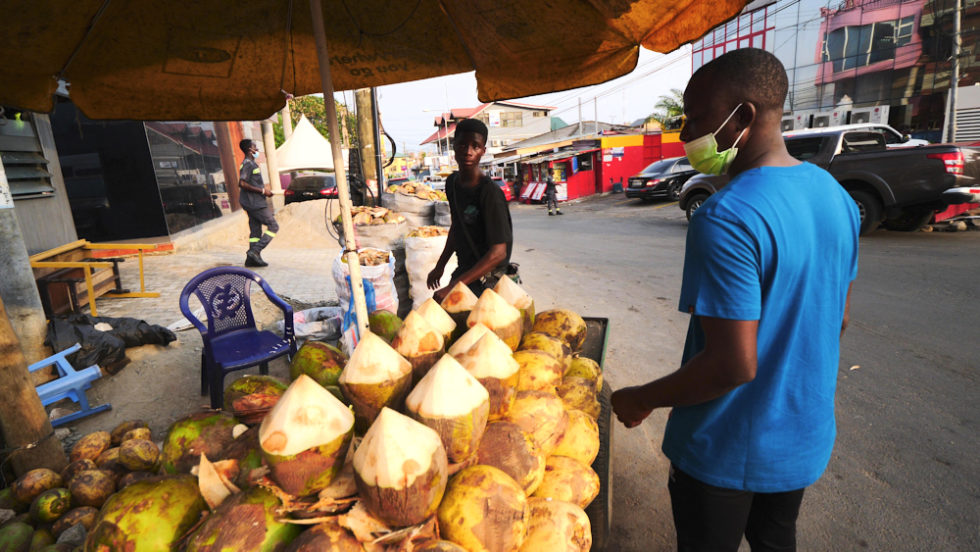
Every time I travel somewhere with a tropical climate, whether it’s India, Brazil, or Ghana, I have to get a fresh coconut. There’s nothing quite like one on a hot, muggy day. Luckily, you can beat the heat in the Osu neighborhood by buying one from a street vendor!
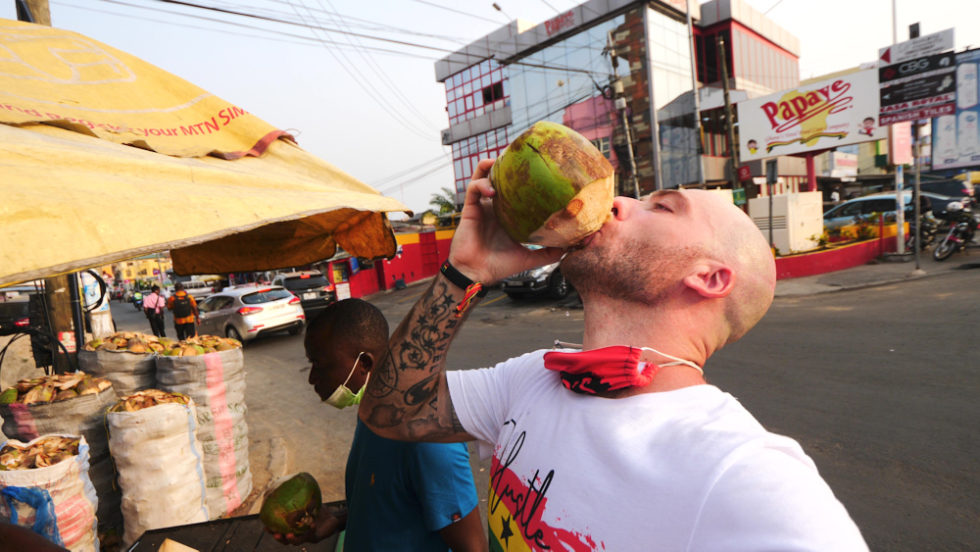
For just $1 USD, you get a whole coconut, which the vendor will cut a hole into using a machete. You then get to drink the refreshing water inside, which is perfect for hydrating on a hot day. Then, if your coconut contains any meat, the vendor will cut it open so you can eat it! It’s a perfect snack!

Beads are commonplace in Ghana, from mainstays in the local jewelry to decorations adorning masks. About an hour outside of Accra, you can see how beads are made at T.K. Bead Industry.

At this impressive factory, you can see the entire bead-making process. First, they wash the glass bottles and pound the glass into a powder. They then place the powder into molds with dyes, and put the molds into an outdoor furnace.
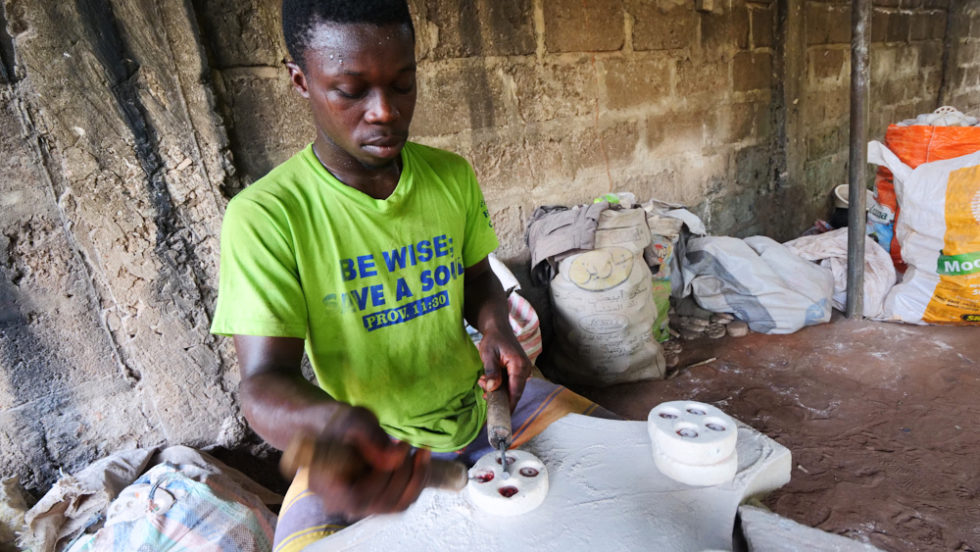
After the glass powder and dyes have melted together, the beads are shaped and holes are made. Finally, the beads are washed and are finally ready to be used in jewelry. Each bead is unique and brightly colored, almost miniature mosaics.

Once you’ve seen the bead-making process, you can visit the workshop where they actually make the jewelry. You can purchase necklaces and bracelets for just 9 cedi each. If you prefer, you can also buy the beads themselves so you can make your own jewelry with them!
TK Beads
Amrahia Dodowa Road, R40
Accra, Ghana
+233 24 472 7853
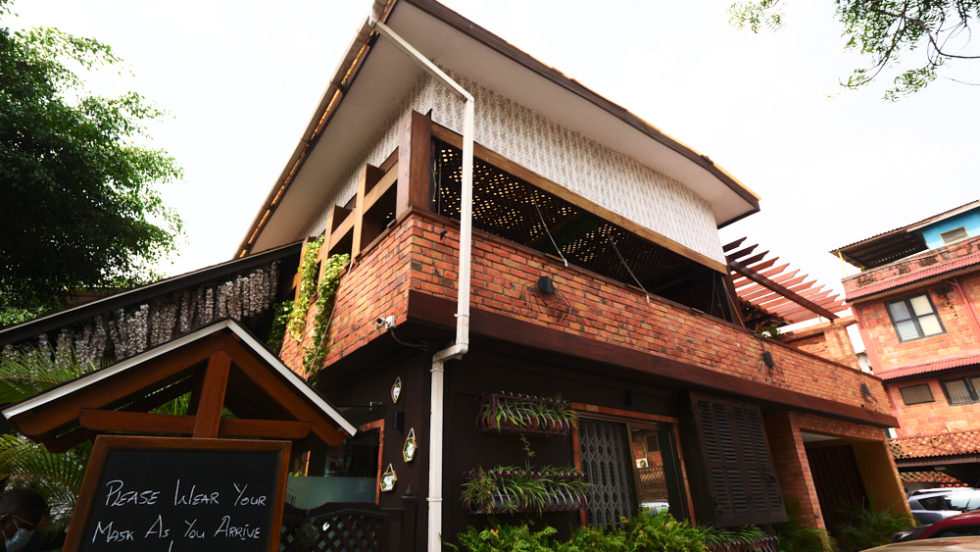
Of all the remarkable foods you’ll come across in Ghana, few are more popular than waakye. Pronounced like “watch-ay,” this West African breakfast food can be found just about everywhere, but I suggest trying a modern version at Buka Restaurant in the Osu neighborhood.

Waakye is a delicious mix of rice and black-eyed beans. At Buka Restaurant, it’s served goat meat in a tomato-based stew with shito, chilies, and an egg. You’ll also get cabbage and gari (cassava flour) on the side.
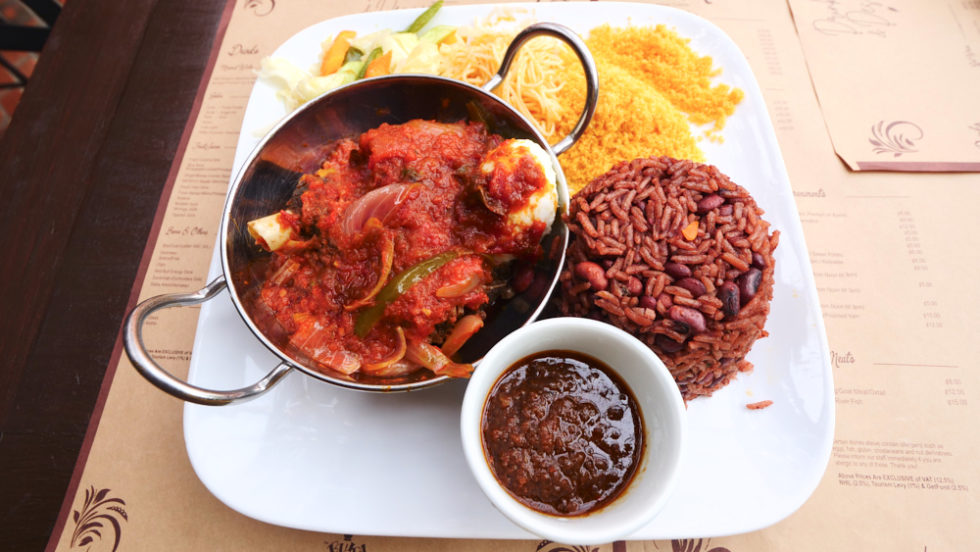
After just one bite, it’s easy to see why waakye is so popular throughout Ghana. It reminded me a bit of arroz con frijoles, but with distinct West African flavors. The fatty goat meat and stew complement the waakye perfectly. I loved the freshness of the cabbage and the crunchy gari!

The flavors range from savory to spicy to earthy, and the mix of textures had my palate going nuts with each bite. Best of all, the goat bones contained a nice amount of savory, mouthwatering marrow.
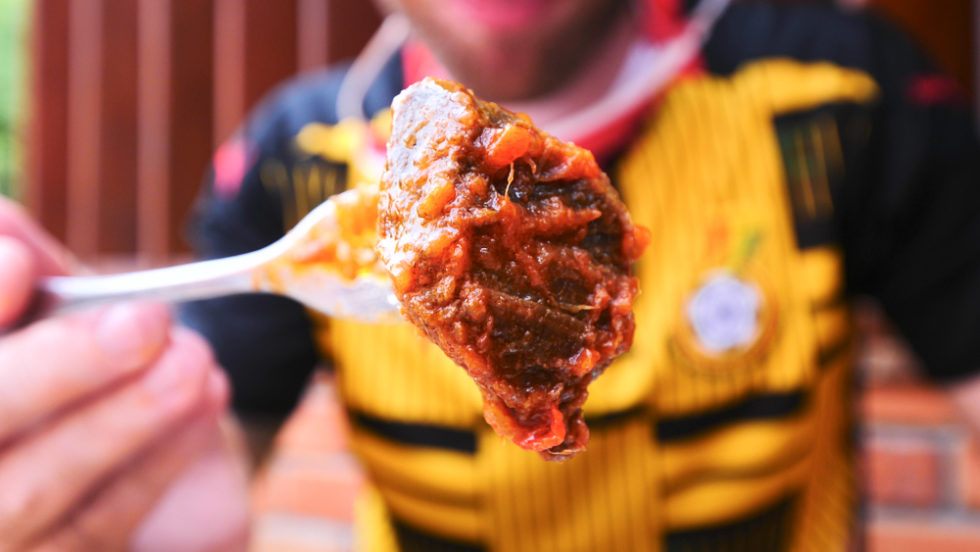
I can’t recommend this dish or Buka Restaurant more. It’s one of my favorite things to do in Accra, Ghana, and was one of my favorite food experiences in the city!
Buka Restaurant Osu Accra
10th St.
Accra, Ghana
+233 55 649 2290
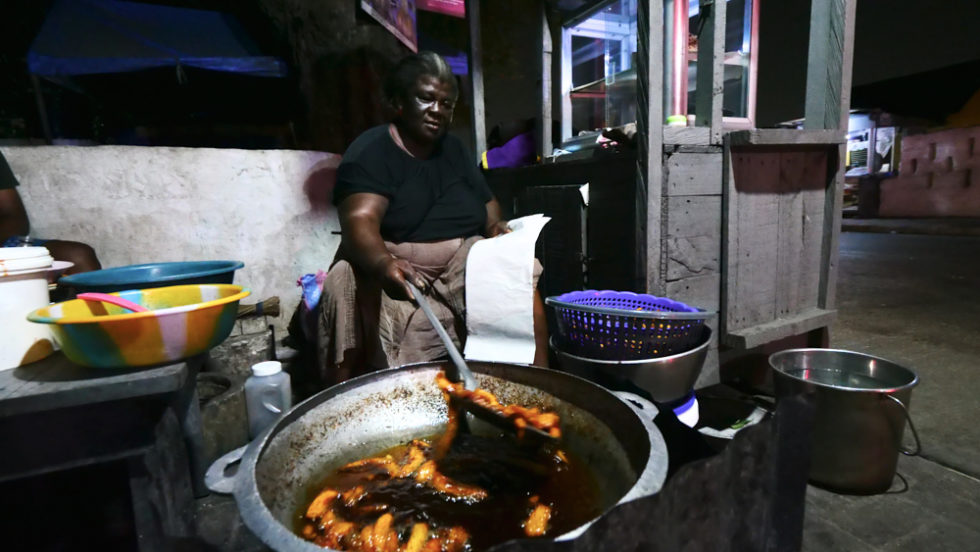
If you find yourself in the Osu neighborhood after dark, I strongly advise heading out to explore the legendary Osu Night Market. The location is actually open 24 hours a day, but you’ll only find street food vendors after nightfall. It’s some of the best street food in town and is among my favorite things to do in Accra, Ghana.
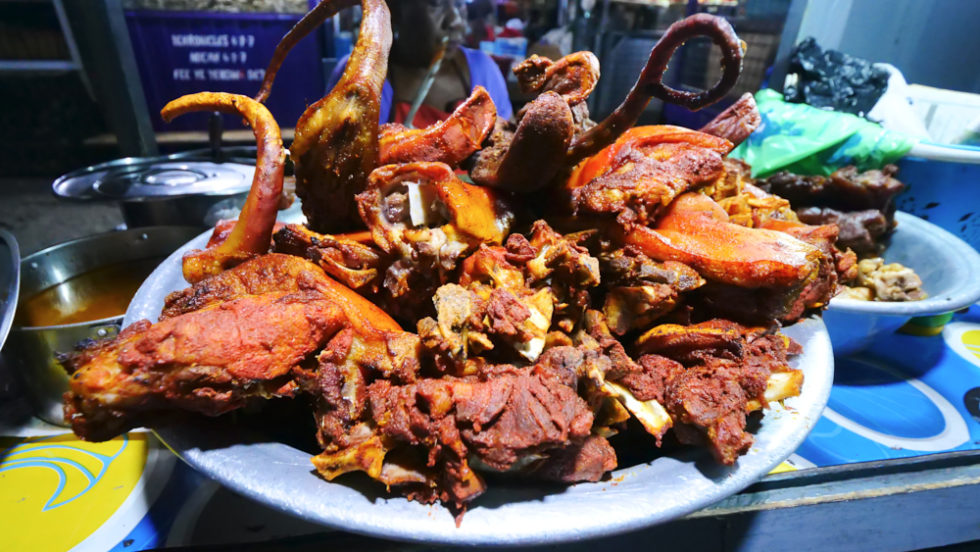
The market dates back over 420 years and is popular among locals even after midnight! After trying the dishes offered there, I can see why. The fatty and crunchy fried pork is full of incredible flavor and has a decent spice level to it. If you’re not into fried pork, they also have smoked, grilled, and fried fish, as well as spicy grilled organs!
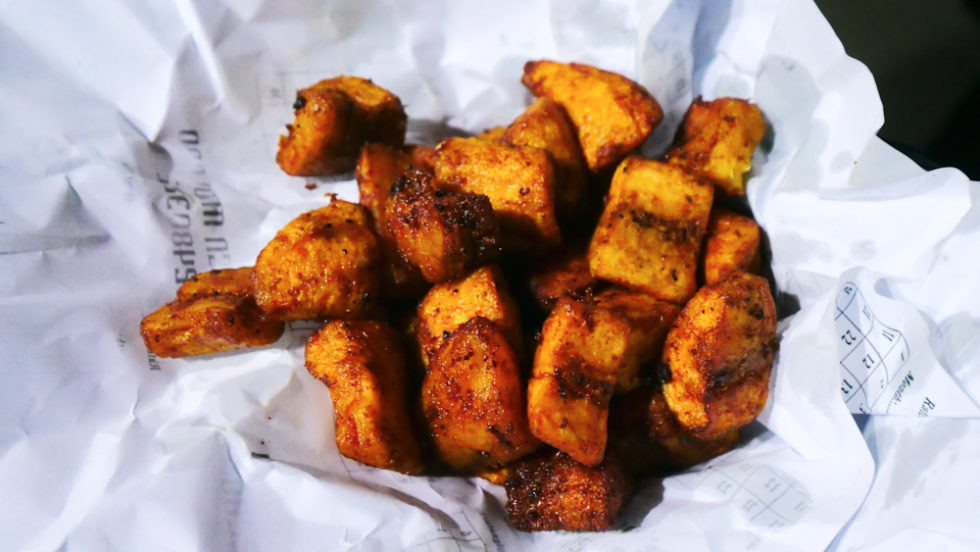
Another local favorite you can find in the market is kelewele, a type of cubed, fried plantain. It’s sweet and fluffy, especially if you try it just minutes after it comes out of the fryer. If you’re looking for something light but savory, try the fried squid strips, which are tender and tasty, especially with some shito pepper sauce.

Last but not least, I recommend trying some corn porridge. You can buy a baggie of it for less than $0.20 USD and a cup for a bit more. It’s quite filling and has a slightly bitter flavor with a bit of sweetness to it. Wash it down with some Guinness Foreign Stout or a Club Premium Lager!

Toward the end of my road trip through Ghana, I spent an afternoon in the city of Tamale in the northern part of the country. Food-wise, I didn’t get to experience much northern Ghanaian cuisine, but I made up for it on my return trip to Accra. There, my friend Lotte and I enjoyed an amazing meal at Northern Platter Restaurant.
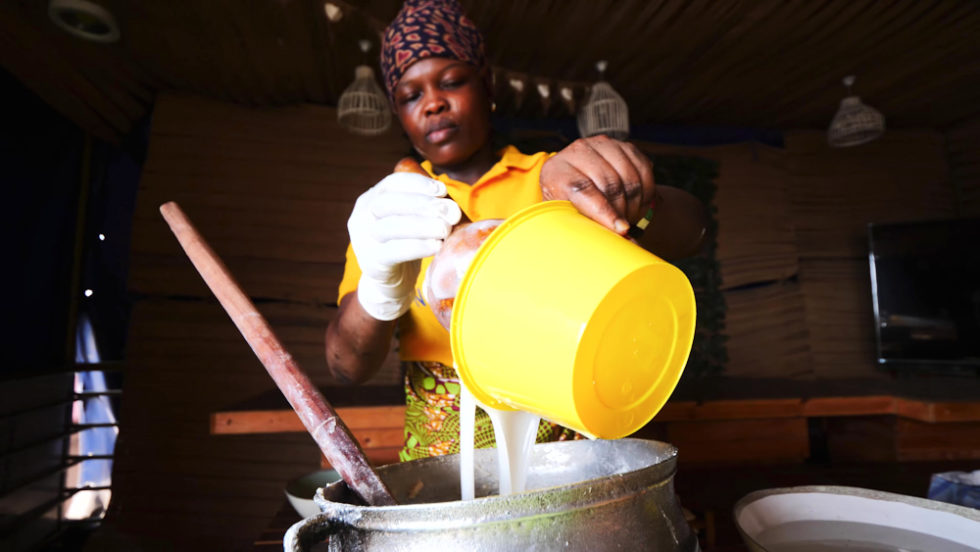
The two-story open-air restaurant has a beautiful dining area, and the cooks prepare dishes right in front of you! I got to watch them make some millet dumplings, corn porridge, and fried wagashi, which is a cheese made by the Fulani tribe.

One of the highlights was the tuo zaafi, which is a starchy paste made from millet. It’s a staple in northern Ghanaian cuisine and comes with a thick, glutinous hibiscus sauce and a fish-and-vegetable stew. It’s light in texture but the flavors are anything but subtle!
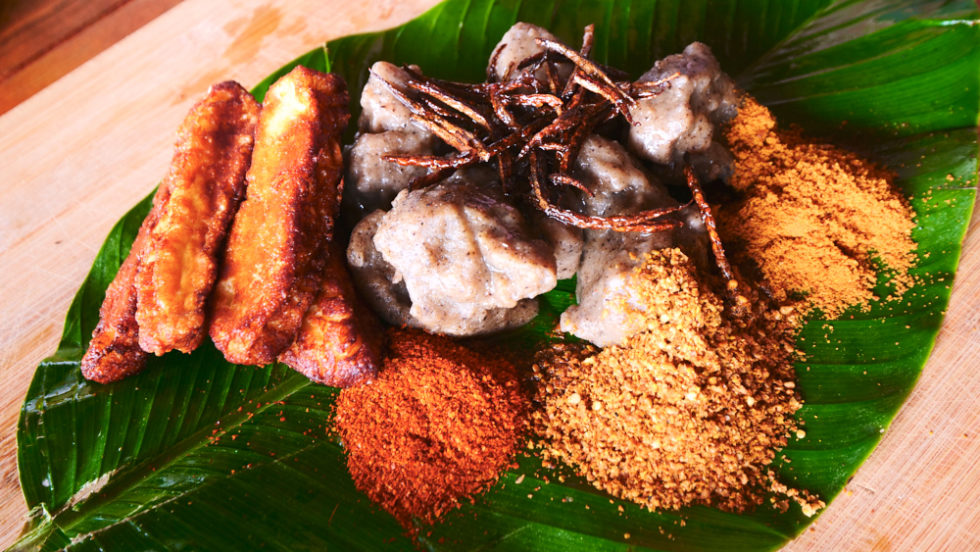
The millet dumplings, which are similar to another northern dish called tubaani, were also fantastic. They come with the fried wagashi and three dipping powders. The chili was nice and hot, while the suya was savory and flavorful. It also came with kuli kuli, which is a spicy, powdered peanut snack.
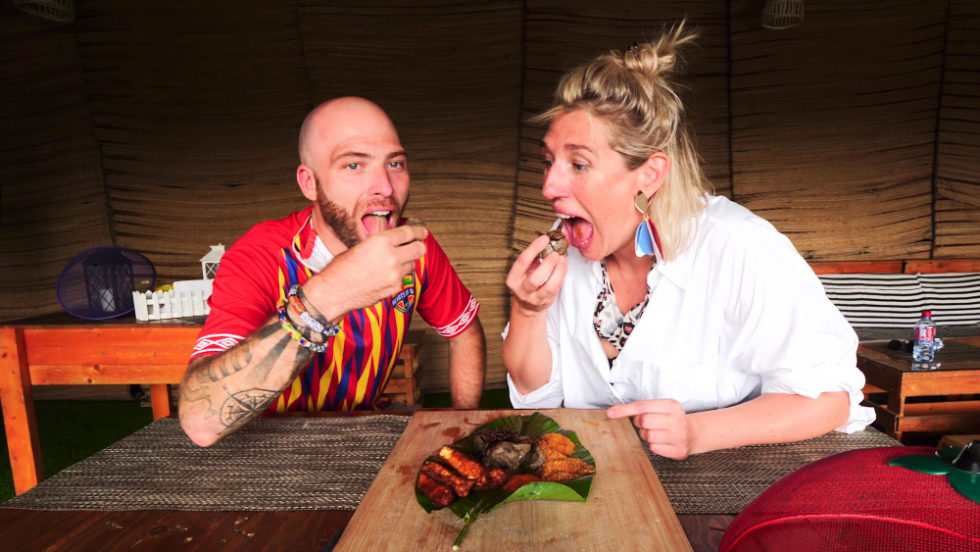
Trust me, no list of the best things to do in Accra, Ghana is complete without visiting Northern Platter Restaurant!
Northern Platter Restaurant
East Legon
Otele Avenue
Accra, Ghana
+233 50 208 8203

Nearly every country I’ve visited around the world has a type of homemade beer or alcohol. Whether it’s the moonshine-like pitorro that people make in their homes in Puerto Rico or the village beer made deep in the jungles of Suriname, they’re always fun to try. In Ghana, one of those alcoholic drinks is pito.
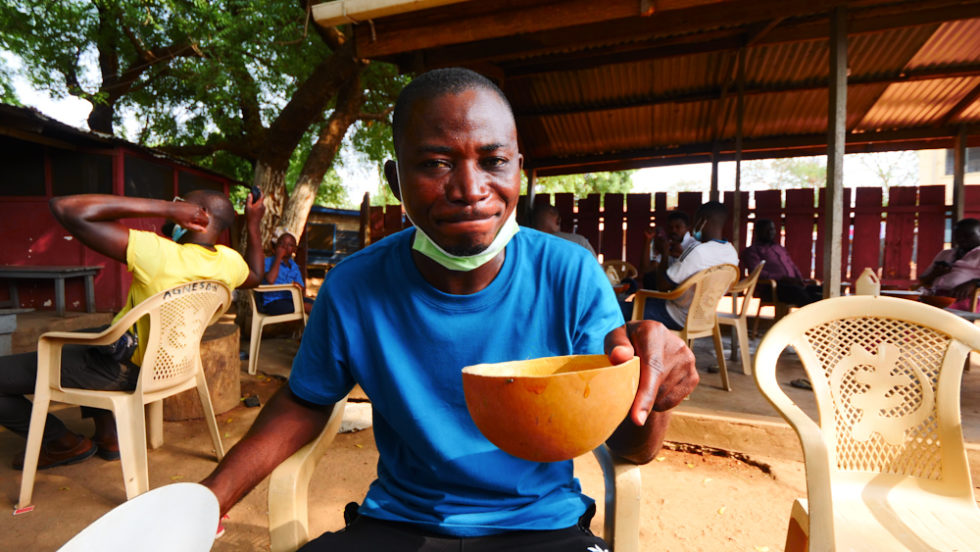
Pito is a beer made from millet. Like the Surinamese village beer I tried in Palumeu, it’s served in a large bowl. It has a yeasty, slightly bitter flavor from the fermentation process. There are multiple varieties, including a lighter-colored one and a darker, cloudier, and non-alcoholic one that’s sweeter! Trying them is among my top things to do the next time you’re in Accra, Ghana.

I visited a small house in town to try the pito. I saw how they soak, dry, germinate, and boil the millet. After sampling some, my guides told me that it’s customary to offer drinks to the other patrons after drinking. Kick pack, enjoy your drink, and pass it on!
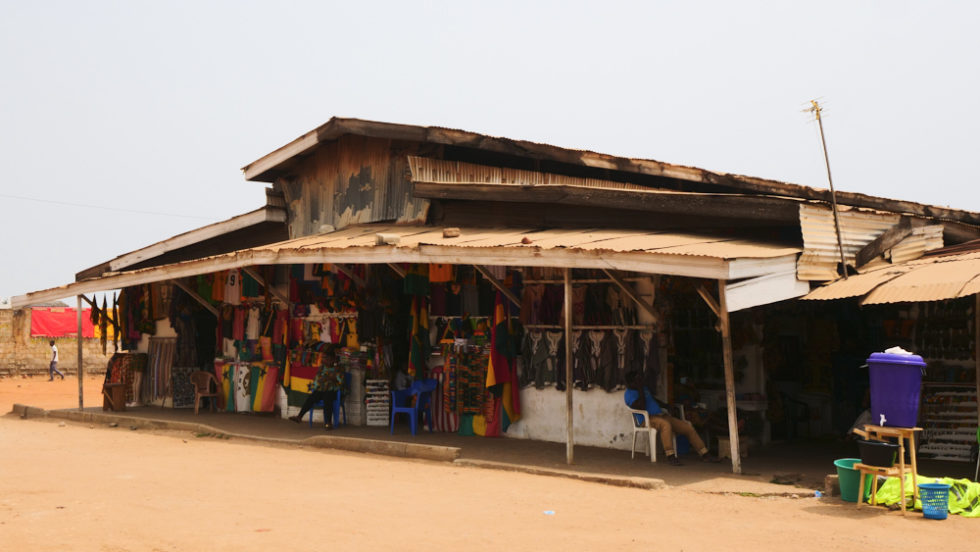
Located just a fifteen-minute walk from the center of Makola Market is a fantastic location called the Craft Center. Actually an extension of the market itself, this is where you’ll find locals making a number of hand-crafted goods, including masks, tables, drums, paintings, and more.

Anyone who has followed my adventures for a while will probably know that I am a collector of masks from around the world. The ones at the Craft Center are made from ebony wood and are absolutely gorgeous. They have been painted, smoothed out, and adorned with decorative beads and bits of metal, and come in all shapes and sizes.
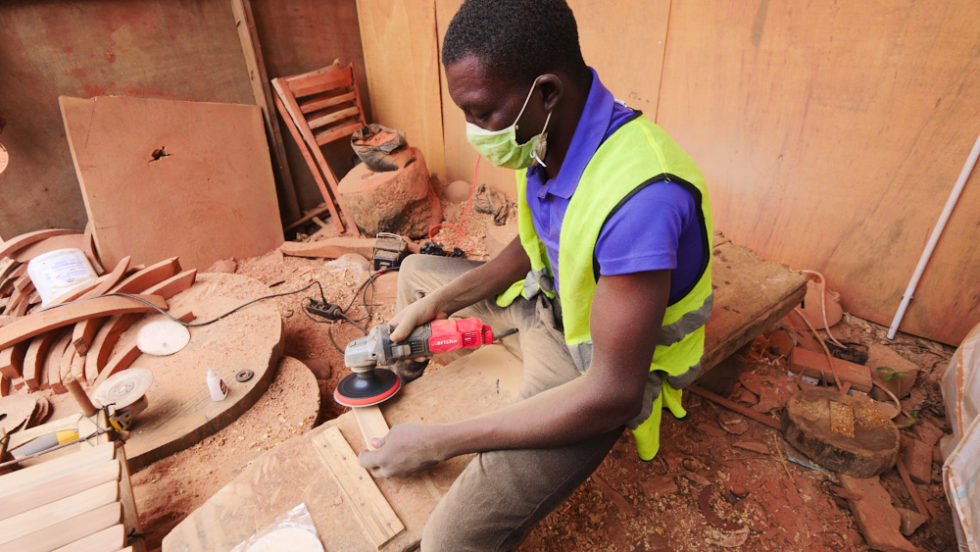
You can watch the expert carvers do their work, and then afterward, head over to Fredgift Enterprise. This shop in the Craft Center sells magnificent antique masks that are over 70 years old! Many of them are of people, but you can also find masks depicting elephants, birds, and other animals.

As they are antiques, they don’t come cheap, though! Some of them will set you back as much as $500 USD, but they’re definitely worth it! If you’re not into masks, you can always buy an official Ghana soccer jersey like I did!

If you’re looking for a fun and lively area for a nighttime food adventure, look no further than the Spintex neighborhood. In addition to lots of bars, you’ll also find a number of restaurants frequented by a mostly young clientele. One of these is Captain’s Catfish Point and Grill.

Here, you can try some delicious Ghanaian catfish, which you choose from a tank. The entire fish is washed with lemon and coated in a flavor-rich sauce and vegetables. Then, it’s wrapped in foil and steamed on the grill!

The steaming process makes the fish unbelievably tender, so much so that it falls apart at the slightest touch. That’s helpful, as you’ll need to dig through it to get rid of the bones.
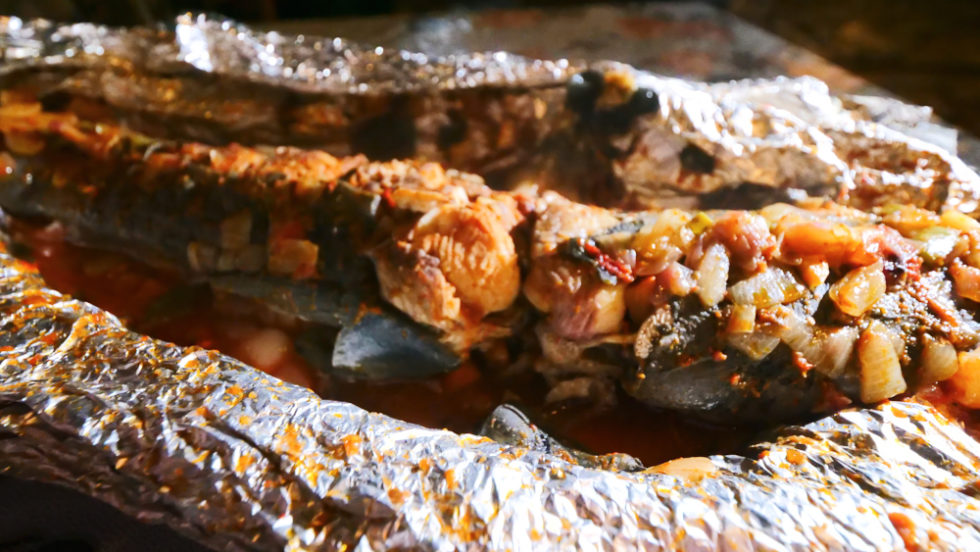
The steamed catfish is unlike anything I’ve ever had in my life. It was spicy and flaky, tender and juicy. It came with a side of yam fries, which taste outstanding dipped into the catfish’s sauce. Best of all, the fish itself is so meaty, it’s big enough to share with a friend and still get full off of it! It’s one of the best things you can do in Accra, Ghana and should be on everyone’s itinerary!
Captain’s Catfish Point and Grill
11 Rd Leading to Spintex-Sakumono, Ghana
+233 54 106 8330

While there’s more than enough for curious travelers to explore in Accra, I highly recommend taking a day to get out of the city. A popular weekend destination for locals is Aburi, a beautiful mountain village roughly 45 minutes north of the capital. Taking a day trip there is easily among the top things you have to do when you visit Accra, Ghana.

Part of the fun of driving to Aburi is enjoying the stunning views over Accra as you head into higher elevations. But once you arrive in the village, there are a number of other things to do.

One of the best things you can do in Aburi is visit its botanical gardens. The road leading into the gardens is lined with tall palm trees. Inside the gardens, you’ll find vendors preparing and selling different kebabs, sausages, and chicken.

I can tell you from experience that the kebabs are fantastic, particularly the beef-and-onion ones. It’s hard to beat that flavor combination, and the fact that they’re made fresh is a plus!

My favorite thing I did in Aburi was check out its craft market. There, you’ll find vendors and artisans selling incredible handmade products. They include wooden items like stools, masks, chairs, and figurines of people and animals.

The craftsmanship on display throughout the market is stunning. I came across artisans whittling a palm tree into a wall carving, wooden giraffes as tall as I was, and even masks adorned with aluminum accents.

I’m a huge advocate of shopping at local craft markets when I travel. It’s one of the best ways to support the local community and their economy. Best of all, buying handmade crafts ensures that you’re getting a one-of-a-kind piece that was made with love and isn’t mass-produced. It’s a win-win!
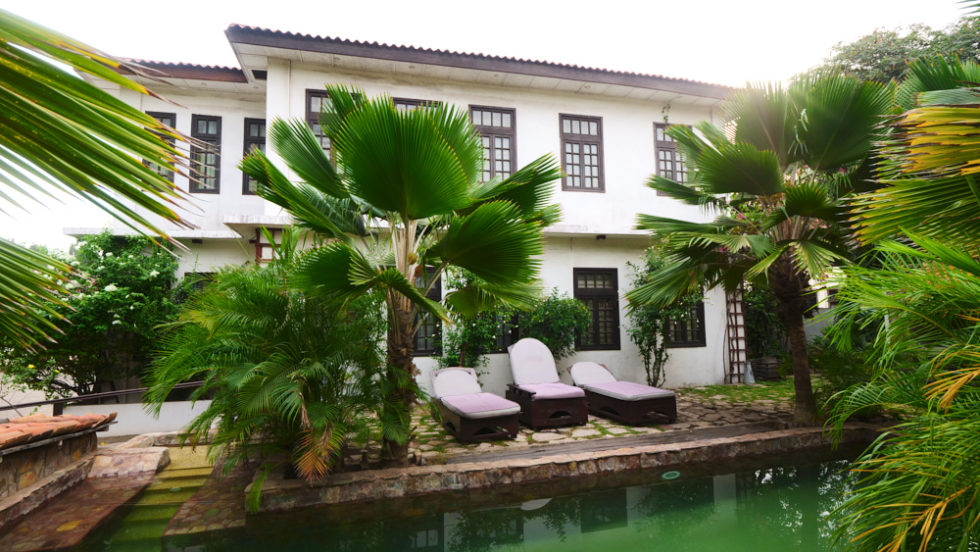
To get to all the top things to do in Accra, Ghana, you’ll need to stay in town for at least a few days. As far as accommodations go, there’s no better place to lay your head than OLMA Colonial Suites. This beautiful hotel in the Osu neighborhood is surrounded by greenery, making it feel like an oasis in the middle of a city!
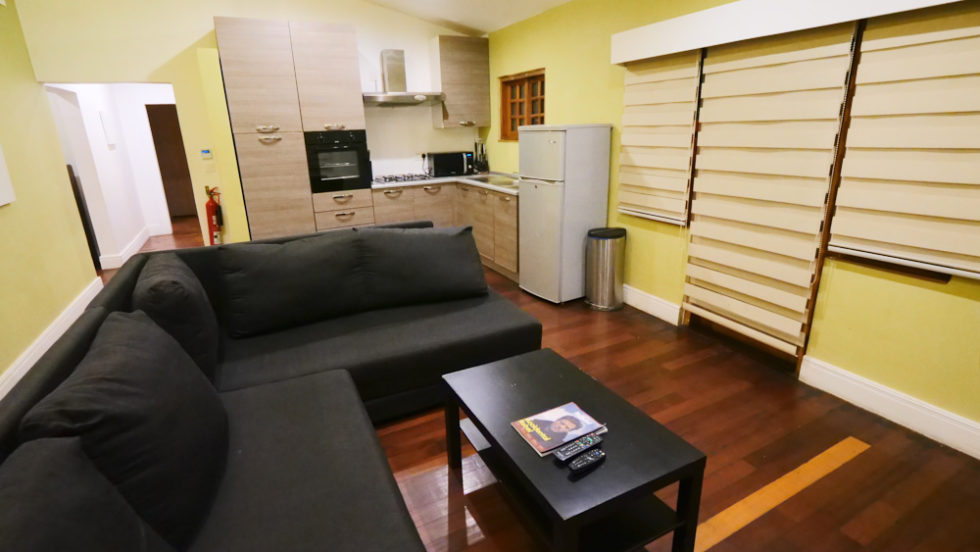
There are only 11 rooms there, so be sure to plan your trip well in advance of your arrival if you want to stay there. My room was a two-bedroom suite that had been decorated with gorgeous paintings done by a famous Ghanaian artist. It boasted a large, modern bathroom; a spacious living room with a couch and TV; a full kitchen decked out with modern appliances; and a cozy dining room.

The guest bedroom offered a comfortable queen-sized bed, while the superb master bedroom had a king-sized bed, storage trunk, vanity, and a fantastic bathroom.

OLMA Colonial Suites has a large pool outside, and also offers free parking, Wi-Fi, complimentary breakfast, and air conditioning. At over $100/night, it may be out of your range if you’re a budget traveler. But if your budget isn’t tight and you want a quiet, luxurious place to stay in Accra, this is the spot for you. The privacy it offers makes staying there one of my favorite things you can do in Accra, Ghana.
OLMA Colonial Suites
333/4 Dadebu Rd.
No. F Osu
Accra, Ghana
+233 50 257 9952
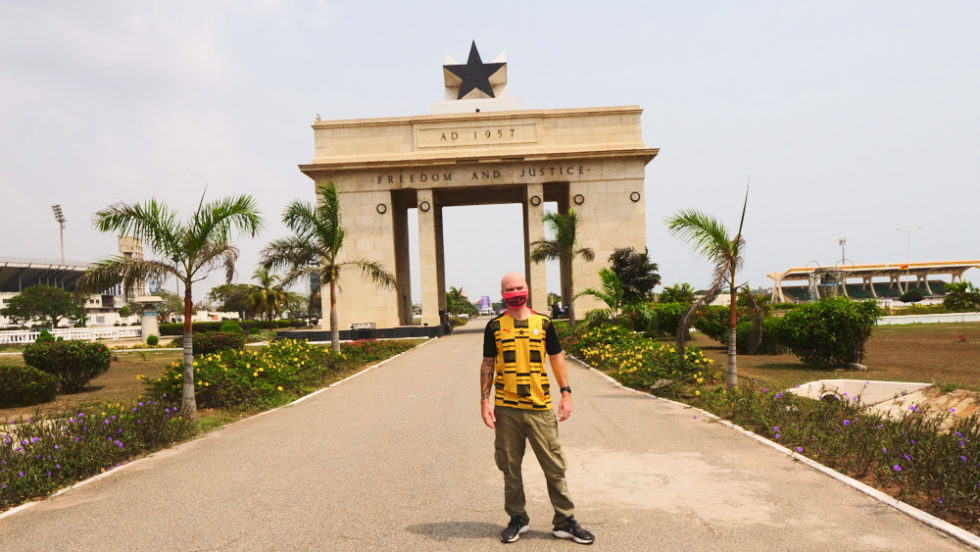
The city of Accra is an incredible mix of history, culture, and gastronomy. Whether you’re visiting to learn more about West African culture or to experience its magnificent cuisine, you’ll find a lot to do there. Experiencing the top things to see and do in Accra, Ghana can be tough, but it is also beautiful. Every location I visit helps further my understanding of the world and brings me new perspectives. Accra did that and so much more for me, and I hope you get to experience it, too. Book a trip to Accra today to see it all for yourself!
NOTE: If you need to check the visa requirements of a particular country, click here. To apply for a visa, find up-to-date visa information for different countries, and calculate the cost of a particular visa, click here!
Counter
101 Countries • 1432 Cities